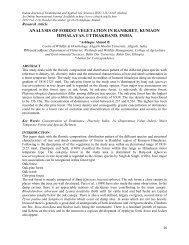epidemiology-clinical profile of cleft lip and palate among ... - CIBTech
epidemiology-clinical profile of cleft lip and palate among ... - CIBTech
epidemiology-clinical profile of cleft lip and palate among ... - CIBTech
Create successful ePaper yourself
Turn your PDF publications into a flip-book with our unique Google optimized e-Paper software.
<strong>CIBTech</strong> Journal <strong>of</strong> Surgery ISSN: 2319-3875 (Online)An Online International Journal Available at http://www.cibtech.org/cjs.htm2013 Vol. 2 (1) January-April, pp.45-51/Banerjee <strong>and</strong> DhakarReview ArticleChild with this anomaly not only suffers for poor dental development but also deprived from breastfeeding due to improper oral seal, swallowing <strong>and</strong> nasal regurgitation, other associated problems arehearing difficulties due to abnormalities in the palatal musculature, <strong>and</strong> speech difficulties due to nasalescape <strong>and</strong> articulation problems (Haug et al., 2012). Though oro-facial <strong>cleft</strong> defects can be surgicallyrepaired in early childhood, but post-surgical residual deformity is due to scarring <strong>and</strong> abnormal facialgrowth <strong>and</strong> development results in continuing functional <strong>and</strong> psychosocial problems. India have diversity<strong>and</strong> varied population which provide huge diverse population in terms <strong>of</strong> genetics, social-demography aswell as cultural difference but lack in proper reporting <strong>of</strong> <strong>cleft</strong> <strong>lip</strong> <strong>and</strong> <strong>palate</strong> registry <strong>and</strong> thus manychildren with this defect is not treated in their early childhood. Thus, <strong>cleft</strong>s have a prolonged, adverseinfluence on the health <strong>and</strong> social integration <strong>of</strong> affected individuals. National epidemiological data on<strong>cleft</strong> <strong>lip</strong> <strong>and</strong> <strong>palate</strong> (CL/P) is not available thus true incidence <strong>and</strong> prevalence to estimated <strong>cleft</strong> <strong>lip</strong> <strong>and</strong><strong>palate</strong> in India is difficult (Mossey et al., 2002). Few scattered data from various studied reported indifferent states <strong>of</strong> country is present thus there is wide variation <strong>of</strong> incidence <strong>of</strong> <strong>cleft</strong> <strong>lip</strong> <strong>and</strong> <strong>palate</strong>ranging from 0.25-2.29 per 1000 live birth is reported. To treat the case <strong>of</strong> <strong>cleft</strong> <strong>lip</strong> <strong>and</strong> <strong>palate</strong>interdisciplinary team is required to meet the st<strong>and</strong>ard <strong>of</strong> treatment apart from surgical intervention. Thuscentralization <strong>of</strong> therapy is needed in country to fulfill the dem<strong>and</strong> considering the burden <strong>of</strong> problem indifferent population <strong>of</strong> states in India.Epidemiology <strong>and</strong> Etiology <strong>of</strong> Problem StatementPrevalence <strong>of</strong> this congenital CL/P deformity is reported as 0.5-2 per 1000 live births depending on thecountry’s population. Cleft <strong>lip</strong> <strong>and</strong> <strong>palate</strong> is more frequent in Asian countries (2.1 in 1000), as comparedto African <strong>and</strong> American countries (Canfield et al., 2006). Incidence <strong>of</strong> CL/P is more in White Americansthan compare to Black Americans. Cleft <strong>lip</strong> occurs more common in male than female whereas <strong>cleft</strong><strong>palate</strong> occurs more commonly in female than in male reason for this is that fusion <strong>of</strong> the palatine shelves1 week later in girls than in boys is thought thus it could be one <strong>of</strong> factor contributing in higher frequency<strong>of</strong> <strong>cleft</strong> <strong>palate</strong> in girls (Jensen et al., 1988). Indian being the second most populous country <strong>of</strong> world withpopulation <strong>of</strong> 1.21 billion, it is estimated that 24.5 million births per year <strong>and</strong> the birth prevalence <strong>of</strong><strong>cleft</strong>s is somewhere between 27,000 <strong>and</strong> 33,000 <strong>cleft</strong>s per year. In India prevalence <strong>of</strong> <strong>cleft</strong> <strong>lip</strong> isestimated as 9.1 per 10,000 depending upon various epidemiological factors such as ethnicity, geographylocation <strong>and</strong> socio-demographic parameter.Various epidemiological studies show that, if one parent affected with a <strong>cleft</strong> has a 3.2% chance <strong>of</strong> havinga child with <strong>cleft</strong> <strong>lip</strong> <strong>and</strong> <strong>palate</strong> <strong>and</strong> a 6.8% chance <strong>of</strong> having a child with isolated <strong>cleft</strong> <strong>palate</strong> (Grosen etal., 2010). Presence <strong>of</strong> a <strong>cleft</strong> in one parent <strong>and</strong> in one sibling is associated with a 15.8% chance that thenext child will have a <strong>cleft</strong> <strong>lip</strong> or <strong>palate</strong>, <strong>and</strong> a 14.9% chance that the next child will have a <strong>cleft</strong> <strong>palate</strong>(Christensen et al., 1996). In case where parents with one is child affected with a <strong>cleft</strong> have a 4.4%chance <strong>of</strong> having another child with a <strong>cleft</strong> <strong>lip</strong> <strong>and</strong> <strong>palate</strong> <strong>and</strong> a 2.5% chance <strong>of</strong> having a child withisolated <strong>cleft</strong> <strong>palate</strong> (Table 1).Untreated <strong>cleft</strong>s <strong>of</strong> the <strong>lip</strong> <strong>and</strong> <strong>palate</strong> is consider as significant health care problem in India leading toaesthetic loss as well as psychological trauma in early childhood to adulthood. Etiology <strong>of</strong> <strong>cleft</strong>s is multifactorial with both genetic <strong>and</strong> environmental factors associated with it. Through various studies it havebeen found that environmental risk factors such as maternal exposure to tobacco smoke, alcohol, poornutrition, viral infection, medications, <strong>and</strong> teratogens in the workplace <strong>and</strong> at home in early pregnancycontribute in etiology <strong>of</strong> this defect (Shi et al., 2008). Certain types <strong>of</strong> anti-epileptic drugs have also beenreported to increase the risk. Genetic factors also make strong hold for occurrence <strong>of</strong> defect. Recently it isfound that gene (Transcription factor) IRF6, the gene implicated in Van der Woude syndrome (VDWS)has been shown to play a strong role in the isolated form <strong>of</strong> <strong>cleft</strong> deformities. Presence <strong>of</strong> <strong>cleft</strong> <strong>lip</strong> <strong>and</strong><strong>palate</strong> is more common monozygotic twin pairs than in di-zygotic pairs (Sivertsen et al., 2008). Folic aciddeficiency also contributes to a range <strong>of</strong> birth defects <strong>and</strong> mostly associations are with neural tube defects<strong>and</strong> cardiac malformations but some evidence through literature search suggest it is also associated with46
















